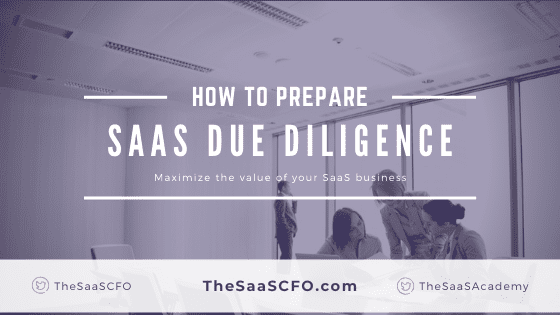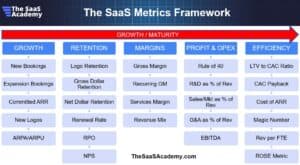You’ve decided that it’s time to take on investment or sell your SaaS company. Or maybe that cold email from a private equity associate finally has you thinking about the next steps for your business. What’s next? Preliminary SaaS due diligence.
Depending on your role and what side of the table you’ve been on, the double “D” word may make you shudder. It’s no small task to complete due diligence if you want to maximize the value of your SaaS company. Many deals have failed because the executive team as not prepared for due diligence.
In this post, I walk through the preliminary SaaS due diligence process. This is beyond the “kicking the tires” phase. You must provide real data that covers many aspects of your business.
And be sure to check out my 1Q25 update on the software M&A markets. What to expect in 2025 and how to prepare. This is a must-listen for SaaS founders and CFOs.

The Initial Call
Once you have responded “yes” to the idea of taking on investment or selling outright, the investment firm (let’s say private equity in this example) will set up an initial thirty to sixty-minute phone call. Typically, this call is with a senior associate and the associate or junior analyst who made first contact.
At this point in the process, the firm does not have enough information about you to have a principal or partner in their firm on the line. That comes later.
The initial call is not an intensive call where they drill you about the numbers and the market. It’s a “get to know you” call. They want to learn about the history of your company, general size, founder story, and of course, if you are interested in selling a piece or all of it.
If you pass some of their initial investment requirements, they will either set up another call with someone more senior in their firm or request preliminary SaaS due diligence data. If you have another call, its agenda will be like the first call but with more nuanced questions that come from someone who has studied a lot of SaaS companies.
Your Turn
But wait! This is also the opportunity for you as the founder and/or management team to ask questions of the investment firm. They have tons of questions for you, but this also your opportunity to interview them.
If you have a healthy SaaS business, it’s likely that you are receiving a bunch of cold calls and emails. You want to partner with a firm that would be a good fit for you and your company.
Here are some questions to consider.
- For example, yes, they know the SaaS business model, but do they know your specific market niche?
- How do they partner with their portfolio companies? Do they have operational executives who help management teams or are they mainly the financial sponsor who offer guidance but don’t get into the day to day operations?
- What’s their investment thesis for your company? Are you the platform purchase or an add-on to an existing portfolio company?
- Have they invested in your niche and what was the result?
The Preliminary SaaS Due Diligence List
Ok, we’ve passed the calls with the firm, and there is interest on both sides in moving forward with the process. What’s the next step?
The firm will then send a you a preliminary SaaS due diligence request list (download below). It’s not an intimidating request list and nothing compared to a full-blown SaaS due diligence process.

However, if you find this list completely mind-blowing, it may be time to hit the “pause” button. Take a step back and see what you need to get in order internally before moving on. Your goal, of course, is to maximize value and if you cannot produce data to support why your company is attractive, it’s hard for the investors to justify a good price to their investment committee.
The preliminary SaaS due diligence list is focused primarily around the following areas. Download my file below to see real request lists.
- Financial History
- Customer and Revenue Data
- Sales and Marketing
- Product
- Human Resources
I’ll explain the intent of each these and what to consider as you prepare your data. Don’t forget to put a non-disclosure agreement (NDA) in place before you send company data.
Financial Statements
The preliminary SaaS due diligence list always includes requests for your financial statements. Investors need to size you up financially to see if your company is going to be a fit based on revenue size, growth, financial metrics, and SaaS metrics.
It’s common to provide three years of historical financial statements. Investors want to understand your revenue mix, your cost structure, and the current economics of your business.

Your financials will be the first impression of your financial and accounting maturity. Do you have a nicely formatted SaaS P&L that is easy to understand?
Or is it a dump of your general ledger accounts which makes it difficult for readers to understand your recurring revenue, gross margins, and major expense categories. The clearer and more precise the data, the easier it is to explain your story and for the investors to understand.
Common Financial Requests
- Three years of historical P&L statements plus YTD P&L for the current fiscal year
- Clear delineation of major revenue streams
- Most recent balance sheet
- Current P&L forecast and budget
- SaaS metrics
Customer and Revenue Data
Of course, your financial statements will be scrutinized, but it’s the data underneath your financials that tell the complete story. Your customer and revenue data provide a view into the health of your recurring revenue. And SaaS valuations are often sized on the direction and health of your recurring revenue.
Revenue Data
Your revenue data must be clearly organized by your major revenue streams. This includes recurring, license, professional services, hardware, transaction, and other.
Make sure your revenue is accurately coded to the correct general ledger accounts so that you can produce accurate revenue reports. If you cannot report on your MRR and customers counts, it’s going to be a hard due diligence process. And it goes without saying that your revenue recognition process must be sound.
Customer Data
Going a layer deeper than revenue, we have our customer data. This is where historical tracking is really important. Every month you should be tracking your bookings.
This includes new, expansion, and downgrades. Then we have churn, both dollar and logo counts. The flip side of churn is retention, both gross dollar retention and net revenue retention.
Wow, that is a lot of customer data! If you are not tracking this data, do yourself a favor and start tracking now. This will save you a lot of pain in the future. It’s data that you need to manage your business.
Common Customer and Revenue Data Requests
- Revenue segmentation by major revenue streams
- Revenue segmentation by product or service
- Top XX customers by revenue
- GAAP/IFRS revenue by customer by month
- New, expansion, and downgrade bookings
- New logos acquired and customer churn
Sales and Marketing Data
Although it’s a team effort to drive new bookings, your sales and marketing structure will receive a lot of attention. Understanding your go-to-market engine will be a key area of their analysis.
It’s important to clearly explain your go-to-market strategy. Whether inbound, outbound, or a mix, there are a lot of moving pieces in sales and marketing.

In addition to the common data requests below, investors will want to know how you win new customers and why you lose customers. Can you truly explain your unique competitive advantage?
Sales and marketing data requests include the sales org structure, how quota/commissions work, sales rep productivity, sales playbooks and much more. This can often be the most difficult area to produce data for due diligence. It exists in reports here and there but not in one master playbook.
From a marketing perspective, they’ll want to know how you generates leads, conversion ratios of leads to opps, and insight into the pipeline creation process. If you target SMB and use an inbound process, you’ll want to explain your trial/sign up pipeline and your SEO/content/paid inbound strategy.
Common Sales and Marketing Data Requests
- Standard sales presentation/playbook decks
- Sales and marketing org chart
- Sales rep attrition
- Competitive analyses or market segmentation reports
- Past and current sales pipeline
- Key competitors
- Your industry segment focus and market size/share
Product
From my experience in preliminary due diligence, you don’t dive too much into the product area. There may be a bullet in the data request list for your technical stack, but there isn’t a deep dive into the backend of your product.
Initial discussions focus on existing product/market fit rather than your database and programming language. Maybe, you will provide a demo in the later stages of preliminary diligence if both parties are interested in a transaction.
Common Product/Technology Data Requests
- Product localization
- Summary of the technical stack and hosting
- Potential product demo
Human Resources
In the first pass of due diligence, the human resources area receives a light review. Investors want to see your org chart and employee census.
An employee census is a roster of your headcount (excluding names) and related data such as annual wage, bonus, commission, hire date, title, department and location. This should be an easy pull from your payroll system.

With this information, investors can understand more about your cost structure. And in combination with your P&L, how much operating leverage that you have in your business. In other words, as revenue and bookings scale, where do you see commensurate headcount growth?
Although the HR requests seem straight forward, trust me. If you are in full due diligence, this area can be very painful if you are above 10MM in ARR. You’ll deep dive into benefit plans, Department of Labor compliance, worker classifications, employee documentation, and more. This is not to scare you but to make sure you are prepared.
Common HR Data Requests
- Employee census
- Company and department org charts
- Historical employment trends and attrition
Investor Teaser Template
Let’s say you get a knock on the door, have a conversation but you are just not interested yet or don’t know enough about the firm. Don’t feel compelled to send data. This is where an investor teaser template comes into play.
You can send this template so that the investor has some information about your company but not too much.
Action Plan
The purpose of this post is to get you thinking about the due diligence process. It’s not to scare you but to prepare you mentally and report-wise. If you are missing a lot of the data and reporting above, you have time to get this data in place if you are pondering future investment or the sale of your SaaS business.
Check out my SaaS Metrics Playbook post on the data and metrics you need to prepare in an exit. Click here.
If you move into full due diligence, you can multiply the data request lists above by ten. There will be deep dives into all areas of your business and maybe some areas you didn’t know existed. If you are above 10M ARR, due diligence will be a painful process if you are not prepared.
It’s important to have processes and technology in place to manage your business as you scale which in turn will help you in due diligence. For example, great sales reporting via your CRM system. Great customer and revenue data from your accounting and revenue recognition system (CFO’s, please avoid rev rec on spreadsheets).
If you would like to see samples of real preliminary SaaS due diligence request lists, download the file below.
What’s your experience with SaaS due diligence?
Download 40+ SaaS metrics templates here to see what you need to understand.
I have worked in finance and accounting for 25+ years. I’ve been a SaaS CFO for 9+ years and began my career in the FP&A function. I hold an active Tennessee CPA license and earned my undergraduate degree from the University of Colorado at Boulder and MBA from the University of Iowa. I offer coaching, fractional CFO services, and SaaS finance courses.


This is an excellent overview for any smaller company wanting to attract investors. The overview is supported by a free download. It’s a must have!
A great write-up!